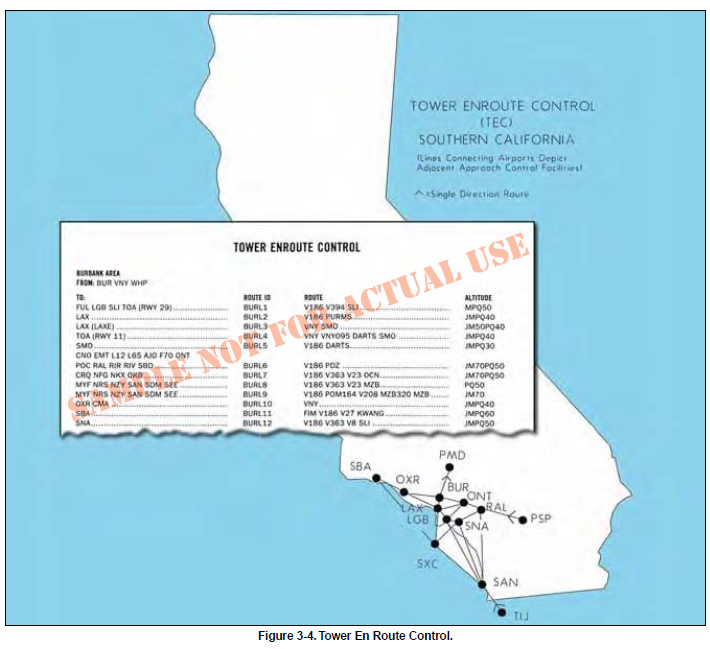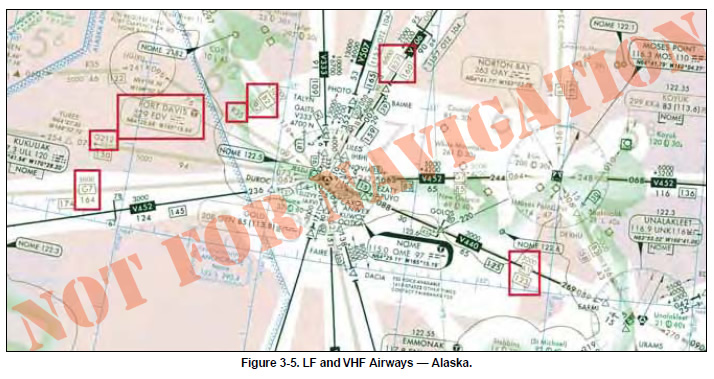|
TOWER EN ROUTE CONTROL
Within the NAS it is possible to fly an IFR flight without
leaving approach control airspace, using tower en
route control (TEC) service. This helps expedite air
traffic and reduces air traffic control and pilot communication
requirements. TEC is referred to as “tower en
route,” or “tower-to-tower,” and allows flight beneath
the en route structure. Tower en route control reallocates
airspace both vertically and geographically to
allow flight planning between city pairs while remaining
with approach control airspace. All users are
encouraged to use the TEC route descriptions in the
Airport/Facility Directory when filing flight plans. All
published TEC routes are designed to avoid en route
airspace, and the majority are within radar coverage.
[Figure 3-4]

The graphic depiction of TEC routes is not to be used
for navigation or for detailed flight planning. Not all
city pairs are depicted. It is intended to show geographic
areas connected by tower en route control.
Pilots should refer to route descriptions for specific
flight planning. The word “DIRECT” appears as the
route when radar vectors are used or no airway exists.
Also, this indicates that a SID or STAR may be
assigned by ATC. When a NAVAID or intersection
identifier appears with no airway immediately preceding
or following the identifier, the routing is understood
to be direct to or from that point unless otherwise
cleared by ATC. Routes beginning and ending with an
airway indicate that the airway essentially overflies
the airport, or radar vectors will be issued. Where
more than one route is listed to the same destination,
ensure that the correct route for the type of aircraft
classification has been filed. These are denoted after
the route in the altitude column using J (jet powered),
M (turbo props/special, cruise speed 190 knots or
greater), P (non-jet, cruise speed 190 knots or
greater), or Q (non-jet, cruise speed 189 knots or less).
Although all airports are not listed under the destination
column, IFR flights may be planned to satellite
airports in the proximity of major airports via the
same routing. When filing flight plans, the coded
route identifier, i.e., BURL1, VTUL4, or POML3,
may be used in lieu of the route of flight.AIRWAY AND ROUTE SYSTEM
The present en route system is based on the VHF airway/
route navigation system. Low frequency (LF) and
integrated LF/VHF airways and routes have gradually
been phased out in the conterminous U.S., with some
remaining in Alaska.
MONITORING OF NAVIGATION FACILITIES
VOR, VORTAC, and instrument landing system (ILS)
facilities, as well as most nondirectional radio beacons
(NDBs) and marker beacons installed by the
FAA, are provided with an internal monitoring feature.
Internal monitoring is provided at the facility
through the use of equipment that causes a facility
shutdown if performance deteriorates below established
tolerances. A remote status indicator also may
be provided through the use of a signal-sampling
receiver, microwave link, or telephone circuit. Older
FAA NDBs and some non-Federal NDBs do not have
the internal feature and monitoring is accomplished
by manually checking the operation at least once each
hour. FAA facilities such as automated flight service
stations (AFSSs) and ARTCCs/sectors are usually the
control point for NAVAID facility status. Pilots can
query the appropriate FAA facility if they have questions
in flight regarding NAVAID status, in addition to
checking notices to airmen (NOTAMs) prior to flight,
since NAVAIDs and associated monitoring equipment
are continuously changing.
LF AIRWAYS/ROUTES
Numerous low frequency airways still exist in Alaska,
as depicted in this NACO en route low altitude chart
excerpt near Nome, Alaska. [Figure 3-5] Colored LF
east and west airways G7, G212 (green), and R35 (red),
are shown, along with north and south airways B2, B27
(blue), and A1 (amber), all based upon the Fort Davis
NDB en route NAVAID. The nearby Nome VORTAC
VHF en route NAVAID is used with victor airways
V452, V333, V507, V506, and V440.

|
